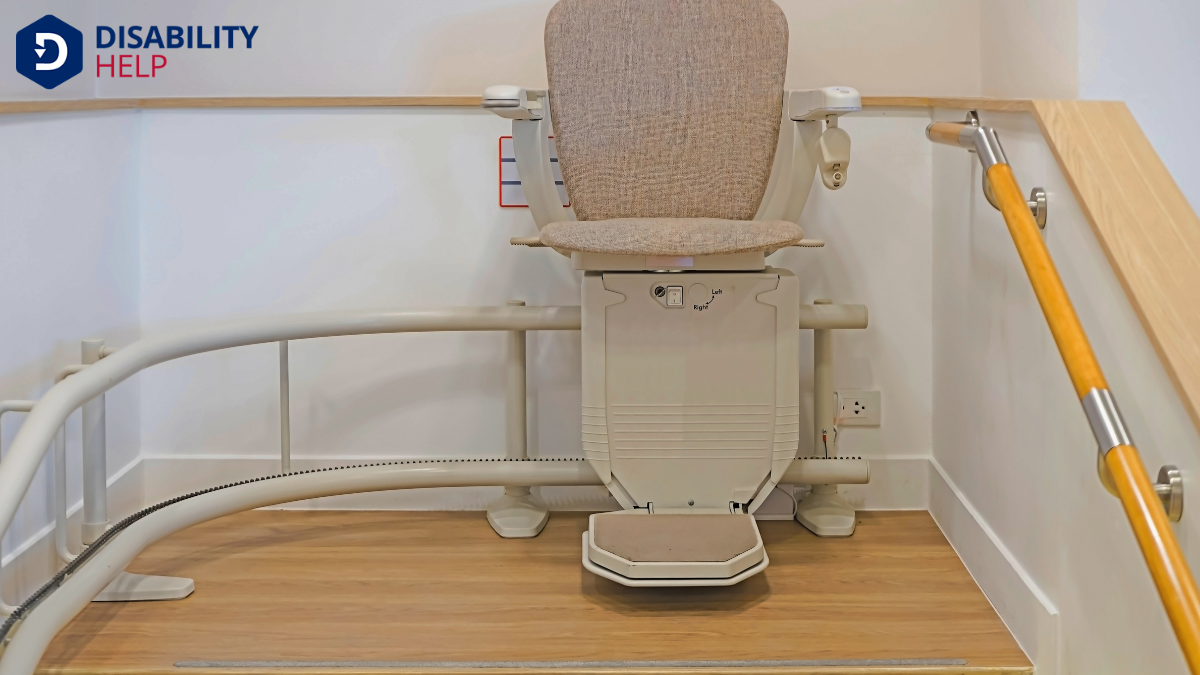Have you ever wondered how a standingThe legal right to bring a lawsuit, which requires that the individual bringing the suit has a direc... stair lift works? Let’s explore the inner workings of these remarkable devices. Standing stair lifts combine an efficient rail system and a powerful electric motor to glide users safely between floors. With intuitive controls and advanced safety features, they offer independence to those with mobility challenges. But how do all these components come together to guarantee a seamless experience? Let's find out.
Key Takeaways
- A standing stair lift uses an electric motor to convert electrical energy into mechanical motion for smooth vertical transportation along staircases.
- Users control the lift through a simple control panel, enabling easy operation and safe standing or leaning during use.
- Safety features include grab barsBars installed in bathrooms or other areas to provide support and prevent falls for those with mobil..., safety harnesses, and emergency stop buttons to ensure user protection while on the lift.
- The rail system is designed with precision engineering to allow smooth transitions, even around curves or landings.
- A battery backup system ensures the lift functions during power outages, with a low-battery indicator for timely maintenance alerts.
Understanding the Basics of Standing Stair Lifts
Standing stair lifts offer a practical solution for those who need assistance traversing stairs but prefer to remain upright.
These lifts are designed with safety and convenience in mind, allowing us to maintain mobility without compromising our comfort. At their core, standing stair lifts consist of a platform or small seat where we can securely stand or lean against while ascending or descending stairs. A simple control panel lets us operate the lift with ease, ensuring a smooth journey between floors.
Standing lifts come equipped with safety features like grab bars and safety harnesses to provide stability. They suit narrow staircases where traditional seated lifts mightn't fit.
The Rail System: Ensuring a Smooth and Safe Journey
Let’s explore how the rail system of a standing stair lift guarantees a smooth and safe journey.
We’ll look at the design features that keep the ride steady, the safety mechanisms that protect us, and the track materials that enhance durability.
Understanding these elements will give us confidence in the lift's reliability and comfort.
Rail Design Features
The rail system of a standing stair lift is the backbone that guarantees a smooth and safe journey up and down the stairs. We should consider how its design features directly impact our experience.
Rails are typically made of sturdy materials like aluminum or steel, ensuring durability and stability. They're designed to fit snugly against the staircase, reducing obstructions in our home.
The precision engineering allows for smooth shifts around curves or landings, accommodating various stairway designs. We also find that rails come with a slim profile, minimizing visual impact while maximizing functionality.
Installation is non-intrusive, preserving the staircase's integrity. As we explore these features, it's clear that the rail system is both a technical marvel and a practical solution.
Safety Mechanisms Installed
While riding a standing stair lift, our safety is paramount, and several mechanisms are in place to guarantee it. The rail system plays an essential role.
First, sensors detect any obstacles that might obstruct our path. If something is in the way, the lift halts immediately, preventing accidents. Additionally, the rail system includes a safety brake that activates if the lift moves too fast, ensuring a smooth ride.
We've also got call and send controls, letting us operate the lift from either the bottom or top of the stairs. This feature ensures we don't need to be on the lift to control it.
Finally, an emergency stop button is within easy reach, allowing us to halt the lift instantly if necessary.
Track Material Choices
As we explore the safety features of a standing stair lift, it's equally important to contemplate the materials used in the rail system. The rail, often crafted from aluminum or steel, proves essential for durability and smooth operation.
Both materials offer distinct advantages: aluminum is lightweight, reducing strain on the structure, while steel provides unmatched strength and stability. We must consider the specific needs of our home environment when choosing between them.
Moreover, the finish of the rail system can impact its longevity and appearance. Powder-coated finishes resist corrosion and wear, making them a popular choice.
Understanding these material choices helps guarantee our stair lift not only functions efficiently but also stands the test of time, offering reliability and peace of mind.
The Power Mechanism: Driving the Lift

Let's explore how the power mechanism drives the standing stair lift.
We'll first look at the electric motor's role in propelling the lift along the track, and how a battery backup system keeps it running during power outages.
Additionally, we'll examine how the track and gear interact to guarantee a smooth ascent and descent.
Electric Motor Functionality
To fully appreciate the efficiency of a standing stair lift, we need to understand how its electric motor functions as the powerhouse behind its operation. The motor converts electrical energy into mechanical motion, allowing the lift to glide smoothly along the track.
It's designed to produce consistent and reliable movement, guaranteeing that users experience a stable ride up and down the stairs.
Let's consider how this works. The electric motor engages with gears and pulleys to move the lift. It’s equipped with safety features that prevent sudden stops or jerky motions.
In addition, the motor operates quietly, providing a comfortable and unobtrusive experience. By focusing on efficiency and reliability, the motor guarantees that stair lifts remain a practical solution for mobility challenges.
Battery Backup System
When considering the reliability of a standing stair lift, we can't overlook the importance of a robust battery backup system. This system guarantees that the lift operates even during a power outage, maintaining our safety and independence. The battery backup engages automatically, seamlessly taking over when the main power supply is interrupted. We don’t need to worry about getting stranded mid-journey on the stairs.
Let’s explore how this works: the battery is typically a rechargeable type, charging while the lift is in use or parked. This constant charging keeps it ready for emergencies.
We also benefit from a low-battery indicator, alerting us when it's time for maintenance. With this setup, we can trust our stair lift and focus on what truly matters.
Track and Gear Interaction
While the battery backup guarantees continuous operation, it's the track and gear interaction that truly powers the lift's movement. Imagine a train gliding along rails; similarly, our stair lift relies on a precisely engineered track. This track guides the lift smoothly up and down the stairs.
The gear, often driven by a motor, meshes with the track to propel the lift. As the gear turns, it pulls the lift along the track. This interaction guarantees a steady, reliable ascent and descent.
Let's also consider friction. The gear’s teeth grip the track tightly, preventing slips. We've designed it this way to prioritize safety and stability.
Understanding this mechanism helps us appreciate how each component collaborates to create a seamless stair lift experience.
Safety Features: Harnesses and Stability
Guaranteeing user safety is paramount when it comes to standing stair lifts, and understanding the key features like harnesses and stability mechanisms is fundamental.
We need to focus on how these features keep us secure during use. Harnesses provide essential support, acting as a seatbelt that makes certain we remain safely in place. They're adjustable, accommodating various body types, and designed for easy fastening.
Stability is another critical element. The lift's design incorporates a robust platform and stable rail system, preventing wobbling or unexpected movement. Many models include sensors that detect obstructions, halting the lift to avoid accidents.
Customization Options for Different Needs
How can we make a standing stair lift truly fit our unique needs? It's all about customization.
We can choose from a variety of features to tailor the lift to our specific requirements. For instance, if space is tight, compact models are available. We might also consider adjustable handlebars for a comfortable grip or a swivel seat option for easy exit.
For those with specific aesthetic preferences, different colors and finish options are available to match our home decor.
Additionally, we can add safety features like backup power or remote controls to enhance convenience and reliability.
Installation and Maintenance Considerations

Installing and maintaining a standing stair lift doesn’t have to be intimidating if we approach it with the right knowledge and preparation.
First, we need to verify that our staircase is suitable for the lift. This involves measuring the dimensions accurately and deciding on the side of the staircase for installation. Once we've those details, we can engage a professional technician to install it safely and efficiently.
For maintenance, regular checks are vital. We should inspect the lift for any unusual noises or movements and keep the track clean from dust and debris.
It's also important to schedule periodic servicing with a professional to guarantee the system operates smoothly. By staying proactive, we can make sure the stair lift remains reliable and safe for everyday use.
Conclusion
In summary, we've explored the essential components that make standing stair lifts a safe and reliable choice for traversing stairs. From the precision-engineered rail system to the powerful motor and crucial safety features, these lifts are designed with user comfort and security in mind. Customization options allow us to tailor the lift to meet individual needs, ensuring ease of use for everyone. With proper installation and maintenance, a standing stair lift is a practical solution for multi-level living.






